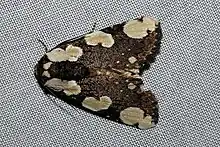| Mudaria luteileprosa | |
|---|---|
 | |
| Scientific classification | |
| Kingdom: | |
| Phylum: | |
| Class: | |
| Order: | |
| Family: | |
| Genus: | |
| Species: | M. luteileprosa |
| Binomial name | |
| Mudaria luteileprosa Holloway, 1989 | |
Mudaria luteileprosa, or the Durian seed borer[1] is a species of moth in the family Noctuidae. It is found in Malaysia,[2] Indonesia,[3] and Thailand.[4][5]
Description
The wings and body are black-brown with medium large orbicular, sometimes cordate whitish maculae. Larvae are pink and bore into seeds of durians. It is considered a pest of Durian and due to its seed boring habit and behaviour, it can corrupt the flesh of the fruit.[1]
Behaviour
The adult moth lays eggs on the fruit near the calyx of the durian seed. When the fruit is 6 weeks old until the harvest period, it pierces through to eat the seed and excretes frass through the opening of the hole of where it bored, with no noticeable exterior damage. The larvae lives in the fruit until the fruit is mature, usually only one larva survives. When the larvae are mature, it will pierce through the rind to settle and make a silk cocoon in cool damp soil underground after going into the wandering stage. Most of the destroyed durian fruit are in the phase that the seed is robust,[1] and the fruit also cannot be sold for fresh consumption. It is recorded to be monophagous. The pupal stage can last 1 month up to 9 months depending on if the climate is favourable.[5] Because of it being a common pest of durian, it has been subjected to pesticides and pesticide testing to combat the pest.[1][6][7][8][9]
Gallery
 Mudaria luteileprosa larva
Mudaria luteileprosa larva Durian seed borer on durian
Durian seed borer on durian Mudaria luteileprosa larva boring into durian seed
Mudaria luteileprosa larva boring into durian seed Pink coloured larva
Pink coloured larva
See also
References
- 1 2 3 4 "Durian Pest: Durian Seed Borer (Mudaria Luteileprosa Holloway) - THEP WATANA". thepwatana.com. Retrieved 19 July 2021.
- ↑ "Mudaria luteileprosa". www.gbif.org. Retrieved 19 July 2021.
- ↑ "BOLD Systems: Taxonomy Browser - Mudaria luteileprosa {species}". v3.boldsystems.org. Retrieved 19 July 2021.
- ↑ Lewvanich, Angoon (2001). Lepidopterous Adults and Larvae (in Thai and English). กองกีฏและสัตววิทยา กรมวิชาการเกษตร. pp. 62 & 147. ISBN 974-436-085-2.
- 1 2 "Durian from Thailand Datasheets - Biosecurity New Zealand". yumpu.com. 2013. p. 26. Retrieved 19 July 2021.
- ↑ Sarute Sudhi-Aromna(Department of Agriculture, Bangkok (Thailand) Plant Protection Research and Development Office Entomology and Zoology Group); Kriengkrai Jumroenma(Department of Agriculture, Bangkok (Thailand) Plant Protection Research and Development Office Entomology and Zoology Group); Arunee Wongkobrat(Department of Agriculture, Bangkok (Thailand) Plant Protection Research and Development Office Research Project Administrative Div ) (2003). "Integrated insect pests management technology to reduce durian seed borer (Mudaria luteileprosa Holloway) problem for export durian". Warasan Kita Lae Sattawawitthaya (in Thai): 152–171. ISSN 0125-3794. Retrieved 19 July 2021.
- ↑ Sutthiarom, Sarut; Sathorn Sirising (Department of Agriculture, Bangkok (Thailand) Entomology and Zoology Div Fruit-Tree and other Hort Crop Insect Pests Research Grop) (1996). "Effectiveness of some insecticides for controlling durian seed borers, Mudaria luteileprosa (Holloway)". Warasan Kita lae Sattawawitthaya (in Thai). 18 (1): 25–33. ISSN 0125-3794. Retrieved 19 July 2021.
- ↑ Beckmann, Volker; Irawan, Evi; Wesseler, Justus (16 December 2009). "The Effect of Farm Labor Organization on IPM Adoption. Empirical Evidence from Thailand". AgEcon Search. Retrieved 19 July 2021.
- ↑ Sudhi-Aromna, Sarut; Kiengkrai Jumroenma (Department of Agriculture, Bangkok (Thailand) Entomology and Zoology Div Fruit Tree (1998). "Appropriate fruit bagging time for preventing durian seed borer, Mudaria iuteileprosa Holloway". Warasan Kita lae Sattawawitthaya (in Thai). 20 (1): 11–17. ISSN 0125-3794. Retrieved 19 July 2021.